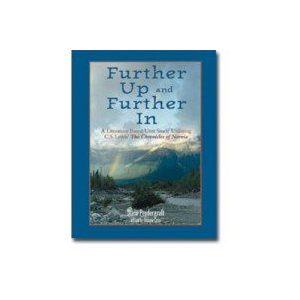Subtitled A Literature Based Unit Study Utilizing C.S. Lewis’ The Chronicles of Narnia, this entry into the unit studies field provides detailed lesson plans for teaching children in grades four through eight, although it might be adapted to suit younger and older students. It is available in print and PDF formats.
While the publisher considers it adequate coverage for all subjects except math, grammar, and spelling, I think coverage of history is a little light. It is very strong in Bible and in character education even though the latter is not a specified subject area.
You will need the seven-volume Chronicles of Narnia (1995 printing of the Scholastic edition is referenced in this study), access to the internet or an encyclopedia, dictionary, a Bible, a Bible concordance, and a thesaurus. Additional recommended resources that are used so frequently that you ought to own them are Genesis: Finding Our Roots by Ruth Beechick, Surprised by Joy by C.S. Lewis, Poems by C.S. Lewis, and Tales from Shakespeare by Charles and Mary Lamb. Other books and videos are recommended for each of the units along with a grammar and composition handbook such as one of the Write Source books for all units.
Some shorter readings such as poems and portions of “Hamlet” are actually reprinted in the back of the book along with some recipes and games. Another useful help is found on pages 261-64; this is a “Subjects Covered” list that organizes topics covered under subject area headings for quick reference.
Art activities, cooking projects, game ideas, and field trips are included in this unit study, but, overall, it is more book-based than activity-based like KONOS and some of the other unit studies. For example, most science assignments are reading rather than experiments. When the topic of light is introduced, students are told to use an encyclopedia or book to study light. They are given a few questions to explore and some vocabulary words to define.
The study is arranged with one unit per book in the Chronicles series. Each unit should take about one month, so that leaves time for extending units if you wish.
A planning guide at the beginning of each unit lists materials and resources you will need, topics for which you will need research information (from encyclopedias, books, or internet), plus suggestions for field trips, and Bible memorization. Then the study of each book is broken down into four sections so that you are reading four chapters per week. Lessons are given for each chapter. Subjects, other than vocabulary words for every lesson, do not seem to be covered in any consistent pattern but depend upon content of each chapter. Thus, in one week there are assignments for history, English, and art one day; Bible, English, science, cooking, and critical thinking the second day; art, English, critical thinking, and history the third day; and critical thinking and cooking the fourth.
Some activities need to be done together, but many can be done by students working independently.
Students use a three-ring binder and divide it into sections to create notebooks for vocabulary, plant studies, and animal studies, plus notebooks for each of the Chronicles books. This could be done with ten separate spiral notebooks, but the binder keeps it all in one place.
Further Up and Further In is likely to appeal to families who love to read together, enjoy variety, and who have children who like to do independent reading and research.









